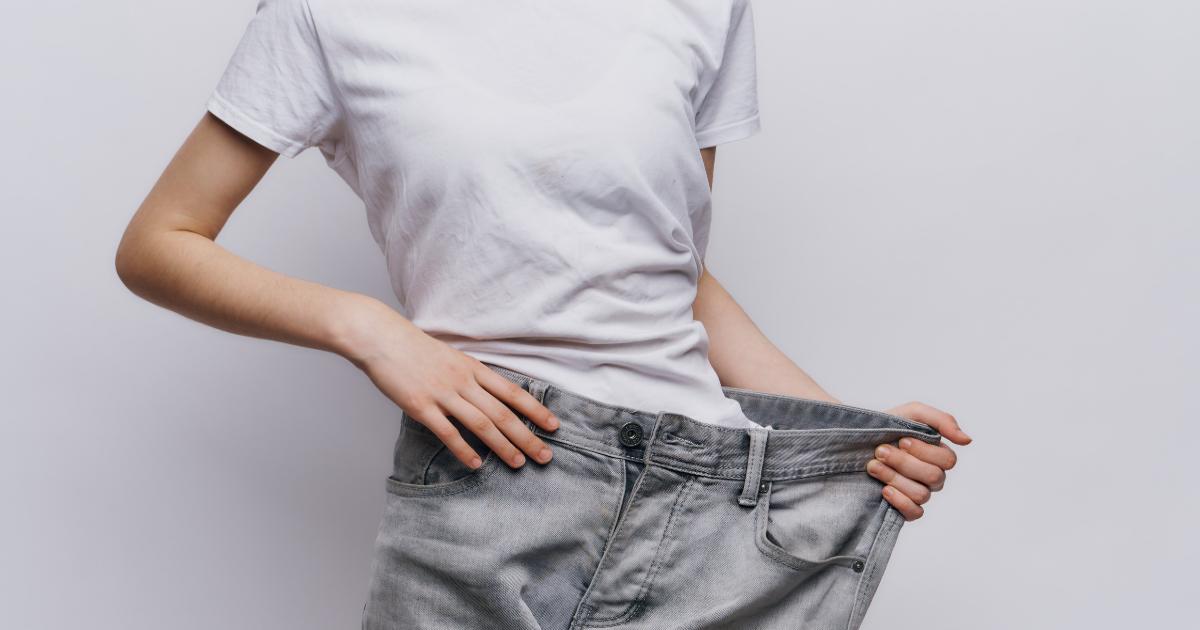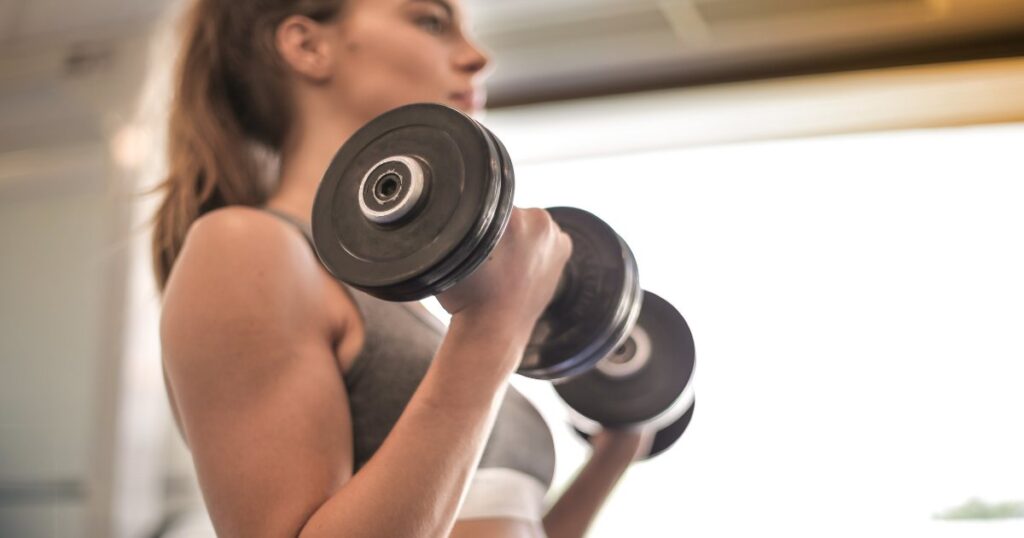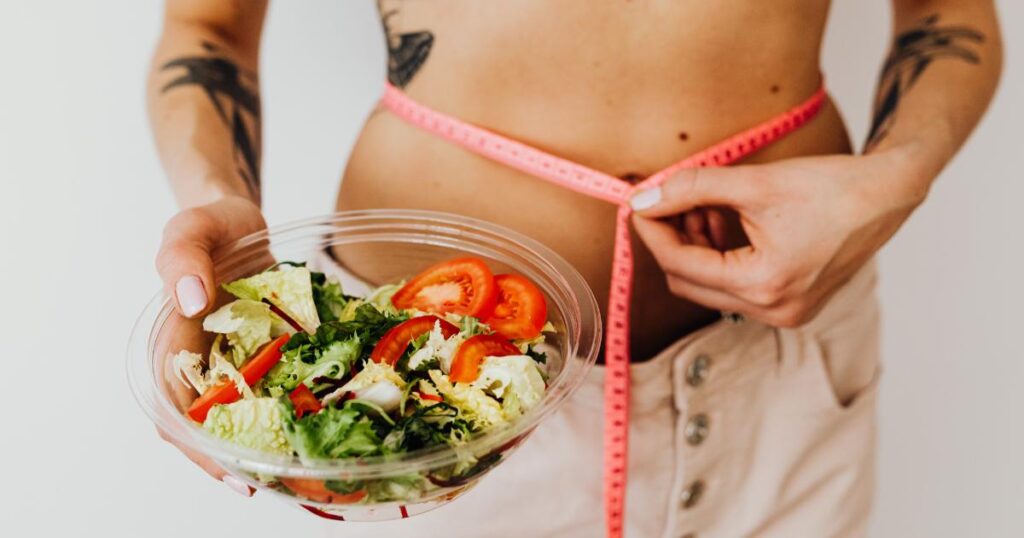
Some say “don’t eat carbs”, “only eat meat”, “go vegan”, “hit the gym”, “do cardio”, or some other magical trick to lose weight, but in fact, there’s only 3 steps to lose weight.
And, when applied correctly, these steps establish a healthy weight loss strategy that is proven to work for anyone.
Start the 3 Steps to Lose Weight Fast
Three factors influence weight loss: eating healthy, moving more, and optimizing health indicators like sleep, stress, and recovery. The great news is that you can start with one step, and still see healthy weight loss fast… and before you know it, you’ll be swimsuit ready!
No need to overwhelm yourself because these steps make it easy to lose weight.
- The most important step in losing weight is…
Out of the three steps to lose weight, the most important is the one that will be the easiest for you to include in your lifestyle, everyday. You seem to enjoy cooking, and you might have experience playing sports or lifting weights. It’s also possible that you’re aware that a lack of sleep or stress is causing you unnecessary troubles.
By observing your tendencies and then considering which step will be the easiest to incorporate, you can begin to tackle that first step, and then add the others.
Step #1 – Optimize Health Metrics (Sleep, Stress, Mindset, Recovery etc.)
Due to the complexity of the human body, things like sleep, stress, mindset, recovery or underlying medical conditions can impede weight loss progress.
So, if you are dealing with stress from a job, family, or some other problem in your life, dealing with the situation first can have a big impact on your weight loss ability. The key is to identify any health metrics that are preventing healthy eating, exercise and sleep habits.
Your Weight Loss Mindset: Attitude Makes All the Difference
There are several healthy mindset strategies you can incorporate to change your personal outlook about dieting and losing weight:
- Forgiving yourself for poor health choices
- Removing the guilt surrounding food or being overweight
- Understanding your “why” (aka what drives you)
- Letting go of intrusive thoughts
- Envisioning success
Most of these are beyond the scope of this article, but check out the link above to read more on changing your mindset.
Sleep
Getting adequate sleep is a basic need and not getting enough sleep contributes to obesity.1 So if you’re constantly running on 6 hours of sleep from binging youtube videos at night, watching too much tv, or simply can’t sleep then it’s time to make a change to your bedtime routine.
Some tips to get better rest include reducing blue light or the use of cellphones, TV’s monitors etc for 2 hours before bed, snacking less at night, and implementing a consistent bedtime routine.
Stress
Being high strung can ultimately cause you to be moody and either eat emotionally or not eat enough; both of which can stall weight loss progress.
If your job, significant other, roommate, or anything else is getting to you then you must find ways to mitigate the stress. Whether that’s participating in de-stressing activities like sports, hiking, dancing etc. or simply cutting the negativity out. Always do what’s in your best interest since stress is an enemy of weight loss and changing dietary patterns.2 Not to mention, stress is a silent killer.
Recovery & Exhaustion
For those beginning their weight loss journey, it is important to understand how exhaustion and muscle recovery work, because working out too hard can also cause plateaus or render the trio of weight loss strategies ineffective. Be sure to assess yourself each day or week before exercising. Getting weaker in your lifts or running slower miles can be a sign of exhaustion, which will make weight loss more difficult.
If this is the case, be sure to de-load or take a week off where you only do a little bit of exercise.
Medical Conditions
Things like sleep apnea, thyroid problems, hormonal imbalances, or even certain medications can cause weight gain AND make it that much harder to get a flat stomach.
If you suspect a medical condition is contributing to your weight problem, it’s imperative to get bloodwork done and speak to your doctor. They will help guide you through any hoops and will be instrumental in getting you back on track.
Step #2 – Move More & Get Skinny Fast

If you dread lifting weights, or your schedule is too hectic to include a dedicated workout, no problem! There are many easy, and effective ways to get your activity level up without spending 2+ hours in the gym (Of course, you can do your lulu’s and start pilates or yoga classes too, if you want).
One of the best ways to burn more calories without getting exhausted or placing undue stress on your knees is with walking.
Walking a minimum of 10,000 steps per day is recommended, but if you work at a desk job this may sound impossible. You can use your iPhone’s health app or smartwatch to see how many steps you’ve been walking a day, and then double that later on. Remember, the trio of steps for weight loss shouldn’t be done all at once and each step should be a small change at first.
It’s important to start small and not look at 10,000 steps like a big bad or scary goal. Even if you’re walking 3-5k steps right now, doubling that will be huge progress. Consider taking walks at work on your 15 minute breaks or after work with a buddy or loved one.
If I Walk a Lot Already, Should I Add Cardio or Weightlifting?
If you’re getting in 10,000 steps already and want to see increased weight loss results, then GO YOU! Weight lifting specifically can change your body composition for good and cardio does wonders for your cardiovascular health.
You can start with either, but weight lifting shapes your body in a favorable manner so you may want to start there. Begin with 3-6 exercises 2-3 days a week is best so you don’t get overly sore and burn yourself out. Don’t worry too much about which exercises to do at first, just choose ones you can do safely.
Once you establish the habit of going to the gym, you can begin increasing the training frequency (times per week) or volume (amount of exercises, repetitions, and sets)with a beginner workout program like Starting Strength Routine.
Cardio is a great idea if you want to focus on stamina, train for a competition, or shed those last few pounds. Cardio or HIIT burns more calories than weightlifting, however, cardio is very taxing so it will spike your cravings and potentially cause hunger pangs.3 So if you’re constantly hungry, it’s best to start with steps first, weight lifting second, and cardio last. If hunger isn’t an issue and you’re happy with your tone-ness, cardio can come before weight lifting.
Weight Lifting Exercises
If you’re new to the gym, it’s best to get on a program like Starting Strength seen above. But if you just want to give it a try, here are a few exercises to begin with.
- Dumbbell Bicep Curls
- Tricep Pull Downs With Cable
- Dumbbell Overhead Press
- Bench Press
- Pull Downs
- Rear Delt Flys
- Lateral Side Raise
- Shrugs
- Pullovers
- Squats
- Glute Kickbacks
- Leg Extensions
- Hamstring Curls
- Calf Raise
- Hip Adduction and Abduction
Cardio & HIIT
Cardio and HIIT (high intensity interval training) go hand in hand, but HIIT is where you vary intensity throughout. So you up the intensity for a little and then go at a slower pace for a few seconds or minutes. It’s common to see a 1:1 ratio and you can work up to a 2:1 ratio.
For example, you could jog quickly for 1 minute and then walk for 1 minute (1:1). Or cycle really fast for 1 minute and cycle slower for 30 seconds (2:1). Other forms of cardio that can also be used as HIIT are:
- Row Machine
- Swimming
- Jump Roping
- Brisk Walking
- Dancing
- Hiking
- Burpees
- Jumping Jacks
Step #3 – Eating Habits: Best Diet To Lose Weight

Although the trio of weight loss strategies sounds somewhat rigid, the best diet to lose weight isn’t a set-in-stone, calorie counting chore. Because everyone has different metabolism rates and personal cravings (especially those of us who love Hagen-Dias ice cream) losing weight means identifying your eating habits and then creating a healthy mindset.
The reason behind this is because if you shame yourself about eating a Krispy Kream donut or two, then you’ll never make progress.
Healthy eating habits that effectively lose weight means it’s you vs. yourself. So set yourself up for success by understanding the cause of your craving for cereal late at night and budgeting in those calories or finding alternatives. Even eating 80% healthy and going hog wild the other 20% of the time is healthier than the standard American diet.
What Are The Best Ways to Eat Healthier?
In order to eat healthier you can approach it one of two ways: Either do your best to track the calories of every single thing you eat… or simply modify some of your eating habits.
Some behavioral changes you can make are:
- Listen to your body, or eat intuitively
- Eat out less, especially fast food4
- Drink less alcohol
- Use smaller plates or utensils
- Snack less
- Eat more fiber or protein (both keep you full for longer)
- Avoid junk food and/or replace it with healthier options (i.e. replacing chips for cheese crisps)
- Eliminate sugar and/or eat fruit instead of dessert
- Avoid refined carbs (white bread, flour tortillas, pasta, pastries, pizza etc.)
- Avoid liquid calories like soda or fruit juice (try infused water or Gatorade zero instead)
Related Reading: Gatorade Zero may be considered for weight loss.
These tips are a good place to start, and remember don’t make it too difficult on yourself. Pick 1-2 things from the list to start and slowly add others when you can.
Tracking Each Calorie: Pros & Cons
If you decide to track calories and log everything you eat, weigh yourself first to figure out if you need more or less calories down the line.
Then, download MyFitnessPal to input the calories and macronutrients (fats, protein, carbs) of each food item. Now eat a consistent amount of calories each day for 2 weeks (be sure to eat a minimum of 1200-1500 calories).
After two weeks weigh yourself to see if you either lost weight, maintained weight or gained. If you gained or maintained weight, eat 200-500 calories less for the next 2 weeks to see if that makes a difference. If you lose weight, just keep up with what you’ve been doing with the caveat that chronic dieting can be detrimental. So be sure to only diet for 6-12 weeks at a time, with a break of at least 4-12 weeks in between.
Food List, Priorities, Macronutrients
When tracking calories, counting your macronutrients (fats, protein, carbs) is essential. Protein is the building block of life and some healthy sources include:
- Chicken Breast
- Fish
- Lean Meats
- Seeds
- Nuts
- Vegetables (broccoli, spinach, asparagus, artichokes, lentils)
- Greek Yogurt
- Cheese
- Milk
- Eggs
Fats get a bad rap, but they’re incredibly healthy if you eat the right kinds. Do your best to eat saturated fats in moderation, avoid all trans fats and prioritize monounsaturated and polyunsaturated fats. Healthy sources of fats include:
- Cheese
- Avocados
- Eggs
- Nuts
- Seeds (chia, sunflower, hemp & flax seeds)
- Coconut Oil & Olive Oil
- Yogurt
- Milk
- Fish (tuna and salmon)
For carbs, it’s best to eat wholesome and non-refined carbs which are less likely to spike your blood sugar (since they have a low glycemic index) and contain fiber, which helps to feel full longer. A few healthy sources of carbs is:
- Potatoes (especially sweet potatoes)
- Oats (high in fiber)
- Rice (brown rice is better)
- Popcorn
- Vegetables (broccoli, carrots, corn, zucchini etc)
- Berries (and other low sugar fruit)
- Beans
- Seeds (high in fiber)
- Nuts (high in fiber)
Finding ways to get skinny fast isn’t rocket science and most “tricks” simply don’t work. However, by incorporating healthy, common sense strategies that focus on overall wellbeing, you can use these 3 steps to lose weight to start shedding fat in a way that will deliver lasting results.
References
1Chaput, J.-P., &; Tremblay, A. (2012, December 11). Adequate sleep to improve the treatment of obesity. CMAJ : Canadian Medical Association journal = journal de l’Association medicale canadienne. Retrieved February 14, 2022, from <https://www.ncbi.nlm.nih.gov/pmc/articles/PMC3519150/>
2Xenaki, N., Bacopoulou, F., Kokkinos, A., Nicolaides, N. C., Chrousos, G. P., &; Darviri, C. (2018, December 17). Impact of a stress management program on weight loss, mental health and lifestyle in adults with obesity: A randomized controlled trial. Journal of molecular biochemistry. Retrieved February 14, 2022, from <https://www.ncbi.nlm.nih.gov/pmc/articles/PMC6296480/>
3Falcone, P. H., Tai, C.-Y., Carson, L. R., Joy, J. M., Mosman, M. M., Mccann, T. R., Crona, K. P., Kim, M. P., & Moon, J. R. (2015, March 29). Caloric expenditure of aerobic, resistance, or combined high-intensity interval training using a hydraulic resistance system in Healthy Men. Journal of strength and conditioning research. Retrieved February 14, 2022, from <https://pubmed.ncbi.nlm.nih.gov/25162652/>
4Bezerra, I. N., Curioni, C., & Sichieri, R. (2012, February). Association between eating out of home and body weight. Nutrition reviews. Retrieved February 14, 2022, from <https://pubmed.ncbi.nlm.nih.gov/22300594/>